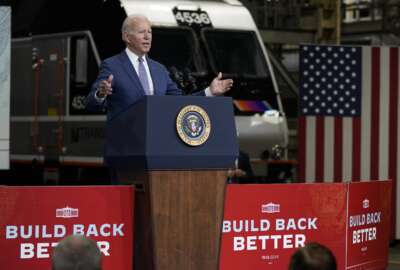Hubbard Radio Washington DC, LLC. All rights reserved. This website is not intended for users located within the European Economic Area.
Biden executive order seeks ‘seamless’ customer experience across federal services
The final executive order contains many of the same elements from a draft version of the executive order that Federal News Network obtained last month.
The Biden administration is looking to make public-facing services across the federal government easier to access.
President Joe Biden signed an executive order Monday focused on improving customer experience within government and building on its ongoing work to improve the equity of public-facing services.
Biden during the signing ceremony said his executive order will “make government work more effectively” so that it’s “not as confusing and straightforward.”
“I know it sounds like a simple thing. I think it’s pretty consequential,” Biden said.
The final executive order contains many of the same elements from a draft version of the executive order that Federal News Network obtained last month, and expounds upon one of three major priorities the administration outlined in its vision for the President’s Management Agenda.
The executive order directs agencies to modernize programs, reduce administrative burdens, and pilot new online tools and technologies that can provide a simple and seamless customer experience.
“When a disaster survivor, single parent, immigrant, small business owner, or veteran waits months for the government to process benefits to which they are entitled, that lost time is a significant cost not only for that individual, but in the aggregate, for our nation as a whole,” the executive order states.
Neera Tanden, a senior adviser to the president, told reporters Monday the executive order looks to reduce the “time tax” associated with seeking out services from agencies.
“It takes a long time to fill out a form or go through a line or access a benefit, and our focus is really ensuring that we’re minimizing those frictions,” Tanden said.
Jason Miller, the Office of Management and Budget’s deputy director for management, said the EO also directs agencies to coordinate work on services that reflect common life experiences, including turning 65 and planning retirement, having a child or applying for a small business loan.
“Those are moments where individuals may need to interact with the federal government in a really critical way at a critical moment, but also may need to interact with multiple agencies. That’s a process that should be simple and seamless. We’re one enterprise and we should operate accordingly,” Miller said.
Lee Becker, the former chief of staff of the Veterans Affairs Department’s Veterans Experience Office, now a vice president and solutions principal for Medallia’s global public sector and regulated industries, said the investment in customer experience “pays for itself,” by increasing the efficiency of agency programs, while also improving public trust in government services.
“If we do it right the first time, meet your customer’s needs the first time, the customer won’t then re-call the call center five times,” Becker said.
Ross Nodurft, a former head of OMB’s cyber team, now the executive director of the Alliance for Digital Innovation, said the executive order sets realistic goals for customer experience across government. He said success, however, will rely on a sustainable funding model for the Technology Modernization Fund and increased investment in the U.S. Digital Service.
“This, to me, is the administration firing a gun at the start of what will be a pretty long race,” Nodurft said.
The executive order gives senior administration officials 90 days to select a limited number of these customer life experiences to prioritize across government. It requires Miller and other members of the President’s Management Council to update Tanden and White House Chief of Staff Ron Klain on progress made improving these customer life experiences every six months.
The EO also gives the General Services Administration six months to develop a roadmap of shared services that agencies can use to improve customer experience.
The administration specifically names Login.gov and the U.S. Web Design System, a set of templates meant to create a common look and feel for agency websites, as tools that all agencies should use to improve federal customer experience.
GSA Administrator Robin Carnahan said the agency, as the home of governmentwide shared services, has a “leading role to play” in meeting the goals of the executive order.
“From disaster relief to student loans, the American people deserve government services that are reliable, equitable, and accessible — without having to navigate a convoluted maze of processes and websites,” Carnahan said.
To help members of the public find and apply for government services, the executive order elevates another GSA-run website, USA.gov, to serve as a “digital federal front door,” rather than require users to navigate multiple federal websites.
To reduce barriers to access for people who are experiencing poverty or rely on social safety net programs, the executive order directs agencies to implement a “no-wrong door” approach, in which users who sign up for one agency program or benefit can get connected to other related programs.
Tanden said this approach would help increase public awareness of agency programs and would reduce the “pain and friction” associated with seeking out these types of services.
Tanden said the Education and Health and Human Services departments are among the agencies taking steps to ensure people who access one benefit are aware of other benefits.
“A lot of what happens with the public is that they’re really just not aware of services that their federal government has available for them, and that is a key component of this executive order, which is that you can go through one door and that door will let you know about other services that can help you in the need that you have,” Tanden said.
Miller said the executive order also outlines steps agencies can take to proactively reach out to individuals.
“There’s also a piece of this that is about notifying people proactively, whether that’s the status of their application or about actions that they need to take, so that we’re meeting people where they are, reducing their amount of time to track ongoing activity in their back and forth with any specific agency, so that we’re making it easier for people in general through these interactions,” Miller said.
The executive order gives Federal Chief Information Officer Clare Martorana and the Office of Information and Regulatory Affairs four months to issue guidance that reduces the burden of collecting information from customers.
The guidance will also direct agencies on how to effectively share customer experience data with each other, as well as state and local governments.
Martorana and U.S. Digital Service Administrator Mina Hsiang said in a blog post that IT modernization remains a “critical aspect of powering an outstanding customer experience.”
“Technology is the connective tissue and a key ingredient in making this vision a reality, and we are proud to be supporting and bringing together agencies across government as a federal enterprise to develop a digital modernization strategy and align our technology investments to deliver for our customers — the American people,” Martorana and Hsiang wrote.
EO names 36 ‘near-term’ agency action items
Aside from setting governmentwide targets, the executive order lists 36 customer experience improvement commitments across 17 agencies, all of which aim to improve the delivery of government services.
Miller said these agency-specific actions are “near-term in nature,” and will generally be completed in the coming year.
Among the agency-specific elements, the EO directs the IRS to allow taxpayers to schedule customer support call-backs, expand electronic filing options and possibly enable automatic direct deposit refunds based on prior-year tax returns.
Miller said the IRS already has a callback option for a limited set of its customer support lines, but would greatly expand these capabilities under the executive order.
The National Taxpayer Advocate, in her latest annual report to Congress, found only 7% of callers to the IRS accounts management phone lines got through to a call center employee.
One of the agency’s most-called phone lines for individual income tax assistance logged about 85 million calls, but only 3% of callers got through to a customer service representative. About 167 million taxpayers call the IRS each year for help.
Miller said agencies across the board “face real challenges enhancing this capability, not just at the IRS.”
“We don’t think people should be waiting on a phone line. They should be able to get through or schedule a call back at their convenience. This is a goal across our services and the IRS is obviously a key piece of that,” Miller said.
For the 2 million people who travel through U.S. airports every day, the EO directs the State Department to allow individuals to renew their passports online, rather than apply at a local post office or passport agency.
Tanden said the State Department expects to launch the capability to renew passports online later this month.
“Our expectation is that can start relatively shortly and I will take time to expand dramatically, but that is something that will start soon,” Tanden said.
The State Department inspector general’s office, in a recent report, confirmed the agency expects to launch online passport renewal this month, but that’s nearly six years past the original timeline in what’s been a decade-long modernization of the Bureau of Consular Affairs’ IT systems.
The executive order also promises new security machines and computers with “advanced screening features” for the Transportation Security Administration that will result in shorter security and check-in lines at airports. Tanden said TSA is considering biometric scanning as one of the next-generation capabilities to improve wait times at airports.
Secretary of Homeland Security Alejandro Mayorkas said DHS interacts more frequently on a daily basis with the American public than any other federal agency.
In addition to TSA’s commitments to customer experience, Mayorkas said FEMA would streamline its online disaster assistance application and work with states to reduce the documentation burden for households seeking disaster assistance.
“The Department of Homeland Security is committed to ensuring the public can seamlessly interact with its agencies and offices and is taking key steps to reduce administrative burdens and improve efficiency, equity, and accessibility throughout the customer experience,” Mayorkas said.
For the 45 million Americans with student loans, the executive order elevates StudentAid.gov as the one and only website for borrowers to apply for, manage and repay their loans. The EO will also streamline the Public Service Loan Forgiveness process for civil servants and active-duty service members.
House Oversight and Reform Committee Chairwoman Carolyn Maloney (D-N.Y.) called the executive order an “innovative plan” to ensure agencies provide excellent customer service to the public.
“By removing bureaucratic red tape and streamlining complicated processes, President Biden is ensuring the American people will have better access to the services they need and deserve. Making sure the government has the right tools, a strong workforce, and proper accountability in delivering critical services is at the core of the work of our committee,” Maloney said.
Rep. Gerry Connolly (D-Va.), chairman of the government operations subcommittee, said the executive order “advances the opportunity for federal agencies to deliver a world-class customer experience and ultimately improve trust in government.”
“With trust in government at an all-time low, it is crucial that the administration and Congress work together to improve how the public interacts and receives services from the federal government,” Connolly said. “Government services should be human-centered and minimize complexity and administrative burden and costs.”
Copyright © 2024 Federal News Network. All rights reserved. This website is not intended for users located within the European Economic Area.
Jory Heckman
Jory Heckman is a reporter at Federal News Network covering U.S. Postal Service, IRS, big data and technology issues.
Follow @jheckmanWFED
Related Stories
OMB offers new guidance on federal contractor vaccine mandate, as compliance ticks up for feds
Energy Dept. backs 17 green federal building upgrades as ‘preview’ of future spending
Related Stories
-
Energy Dept. backs 17 green federal building upgrades as ‘preview’ of future spending Facilities/Construction





